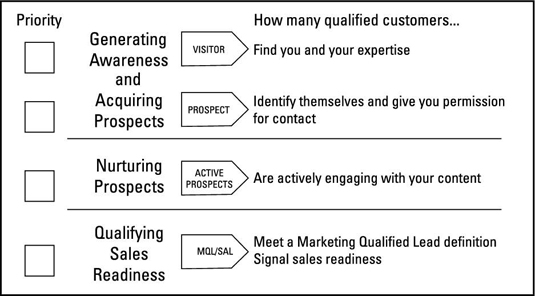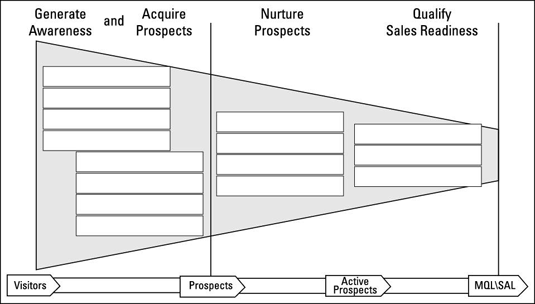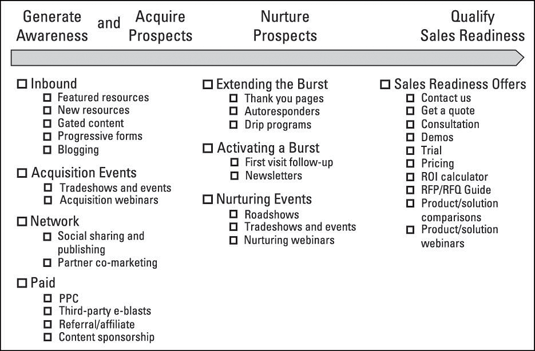Once you set upfront goals for each of your sales campaigns and have a sense for what sales metrics you you might want to measure, it’s time to create a sales road map. Where are your sales now and where do you want them to be in six months, one year, or two years? It's important to develop your milestones and create a plan of attack.
Ask yourself the following four questions:
What are your marketing objectives for the next few years?
Where do you think you have gaps in your current marketing mixture?
What new channels have you been dying to try?
What is your budget?
The next step is prioritizing your objectives. A company called Brainrider Knowledge Marketing Group breaks down your lead generation objectives into four categories:
Generating awareness
Acquiring prospects
Nurturing prospects
Qualifying sales readiness
You want to spend time to prioritize these goals. Take a look at the example in the following figure based on the Brainrider system for prioritizing your lead generation objectives.

After you have determined your priorities, you can begin choosing what lead generation channels make sense for your marketing mix. Just to give you a sampling of what you might want to choose from, consider creating your strategy around the following tactics:
Content marketing
Website
Blog
Social media
Search engine optimization (SEO)
Email marketing
Pay-per-click advertising (PPC)
Content syndication
Direct mail
Event marketing
Inside sales
Lead nurturing and scoring
After you have determined your priorities, objectives, marketing mix, and budget, you can begin crafting your ultimate road map to lead generation awesomeness!
Set up your marketing plan
Now you have to set up your plan to make it accessible and actionable. Your initial setup plan can be in any form that makes it easily understandable for you, your team, and other stakeholders and executives. Start by chronicling your objectives and channel strategy in either an Excel or Google Spreadsheet. The great part about Google Spreadsheets is that everyone on your team can access the plan at any given time, even simultaneously, which is great if you have team members that work from home or who work out of a different office. Having your plan on a regular Excel spreadsheet might cause version control issues, and people might be left with outdated data and information. Another option is using a service like Box or Dropbox to house your spreadsheet. Because it is stored in the cloud and has lock and unlock functionalities, you can also share your latest plan amongst the team.
Next, start matching lead generation tactics to overall priorities (which should map nicely to your sales funnel). For instance, one of the top channels you want to get more exposure in might be content marketing, which maps very nicely to generating awareness for your brand at the top of your funnel.
The following figure based on Brainrider’s plan illustrates this concept and gives you a mapping template to fill in.

Then you can dive down even deeper into all of your programs by creating a list of strategic channels and tactics you intend to employ to be successful attaining your goals. The next figure shows an example of a programs pick list that you can create for this purpose. Of course, your program list and objectives are going to be different, but this gives you a good example of how to set one up.

The final step to your initial planning process is to create a detailed, actionable plan that your marketing team can follow and execute on. Creating a spreadsheet that maps each program to the chosen priority is a great way to stay organized. Also make sure you have date ranges and columns to input your return on investment metrics.
Create a timeline to hit objectives
So many marketers create amazing plans, get their teams excited about the possibilities, and then fall flat because they don’t create a proper timeline to hit objectives. Think big, start small, act fast. This is critical. After you've done all of this fantastic planning, it would be a real bummer if nothing was executed on. Be realistic about what you can accomplish and in what timeframe.
For example, maybe one of your goals is to get 3,000 followers on Twitter. Great goal, but make sure you have set realistic and attainable expectations. Be sure to find the happy medium between too-high and too-low expectations. If you tell your poor social media manager that you need her to execute on this goal and attract 3,000 Twitter followers in three weeks, that's pretty unreasonable. It takes a lot of time to attract followers on Twitter. However, telling her that you need it to happen within the next year is too broad of a goal. A more realistic goal would be to get 3,000 Twitter followers over the course of four to six months, depending on your existing social media presence. And then make sure to have specific key performance indicators (KPIs) in place for every month. Maybe you want your social media manager to work on attaining 400–600 followers each month, for example.
Use a spreadsheet as a place to track monthly goals and develop quarterly and yearly milestones to hit. By communicating them with your team, you will have accountability to make sure that all goals are attained in the allocated timeframe.

